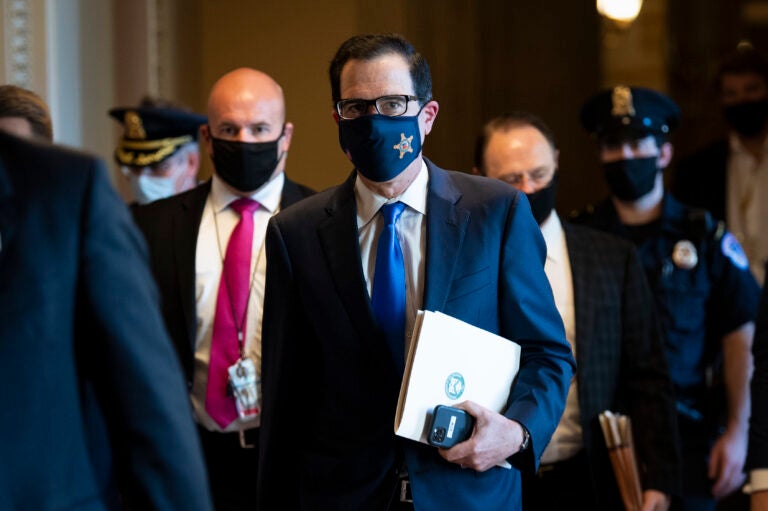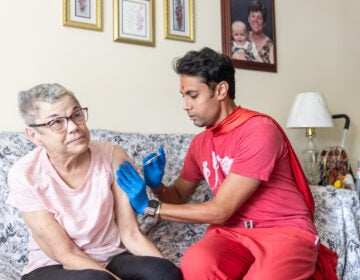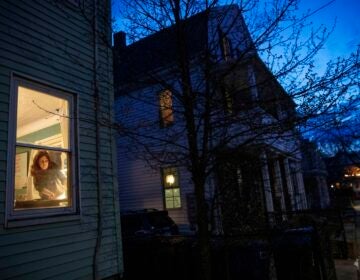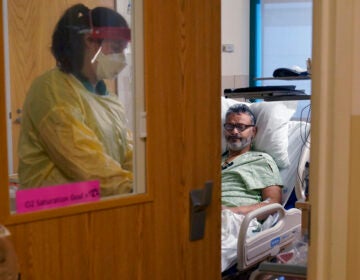Why a negative coronavirus test doesn’t necessarily mean you’re in the clear

Treasury Secretary Steven Mnuchin departs from the office of Senate Majority Leader Mitch McConnell, R-Ky., at the Capitol in Washington on Wednesday, Sept. 30, 2020. (Photo by Caroline Brehman/CQ-Roll Call, Inc via Getty Images)
Several members of Congress and cabinet members who’ve spent time with President Trump in the last week were tested for coronavirus — and have announced the result was negative.
But that doesn’t mean they’re in the clear.
These results could be a false negative — which are common in people who’ve been infected with the virus during the first few days after exposure.
That’s because people who get infected with the coronavirus don’t test positive immediately. It takes several days after they’ve been exposed for the virus to show up in quantities that can be detected by tests, says Rachel Graham, a virologist who studies coronaviruses at the University of North Carolina.
“The average incubation period is about five days,” says Dr. Wafaa El-Sadr, an epidemiologist at Columbia University. That’s the period of time between exposure to the virus and the development of symptoms. “[Though] it could be as short as two days. Or it could be as long as 14 days.”
These estimates are based on a CDC-funded study of publicly reported cases of COVID-19 in January and February.
When someone breathes in droplets or small particles containing the virus, the virus enters the cells lining the nasal cavity and starts to make copies of itself. The first few days are a “tricky period,” Graham says, “where you may or may not have enough replication in the nose to detect [the virus].”
After a few days in the nasal cavity, the virus usually travels down into the lungs, where “it’s got a lot of cells to infect and a nice, warm humid environment to replicate in,” Graham explains. The host (in this case, Trump and his spouse) “can generate really, really high [quantities] of virus,” which move back up into the throat and nose, and spread back out to the world through sputum, snot and respiratory secretions.
This phase of infection — where there’s a much higher quantity of virus in the nose and throat — is when the coronavirus is most likely to be picked up by a swab and detectable in a test, Graham says, “So people are far more likely to test positive further past exposure than from a nasal swab a couple of days after exposure.” In other words, perhaps five days or more after the date of infection.
The incubation period varies by person and situation. “It can depend on the amount of virus they’re exposed to, it can depend on their own health,” says Graham. The president has shared rooms and planes with many people at the White House and on the campaign trail these past days and weeks, including Hope Hicks, a top aide who reportedly felt unwell earlier this week and received a positive coronavirus diagnosis on Thursday.
Among those who’ve been tested this week and reported negative results are Secretary of the Treasury Steve Mnuchin, Representative Nancy Pelosi (who was in a meeting with Mnuchin) and Vice President Mike Pence.
“As has been routine for months, Vice President Pence is tested for COVID-19 every day. This morning, Vice President Pence and the Second Lady tested negative for COVID-19. Vice President Pence remains in good health and wishes the Trumps well in their recovery,” White House spokesman Devin O’Malley wrote on Twitter. In an additional message, O’Malley indicated that Pence has not come in close contact with any recently confirmed cases, including the president.
9(MDAzMzI1ODY3MDEyMzkzOTE3NjIxNDg3MQ001))


![CoronavirusPandemic_1024x512[1]](https://whyy.org/wp-content/uploads/2020/03/CoronavirusPandemic_1024x5121-300x150.jpg)


